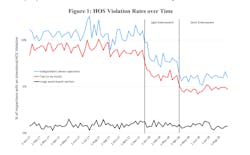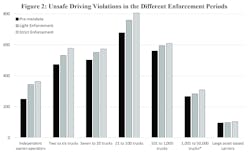We recently analyzed detailed data from the Federal Motor Carrier Safety Administration (FMCSA) to assess how the electronic logging device (ELD) mandate has affected three important transportation safety-related outcomes: hours-of-service (HOS) compliance, accident counts and the frequency of unsafe driving. Our results show that the ELD mandate clearly achieved its first goal: HOS compliance improved considerably, with the frequency of the most egregious violations dropping by roughly 36% shortly after the mandate and by more than 50% when the FMCSA strictly enforced the mandate. Compliance rates of small carriers and independent owner-operators improved the most, with large asset-based carriers practically unaffected because they already used ELDs (and had very few HOS violations).
Surprisingly, the number of accidents for the most-affected carriers did not decrease, and our research indicates, may have increased relative to large asset-based carriers. Finally, the number of unsafe driving violations for these same carriers increased considerably, which could explain why their accident counts did not decrease. This suggests that small carriers and independent owner-operators made up for productivity losses due to stricter HOS compliance by working more rapidly.
This article will discuss the ELD mandate and our findings.
Background
On December 18th, 2017, the FMCSA enforced a mandate requiring nearly all truck drivers to use an ELD to track their working hours. ELDs are harder for a driver to manipulate compared to traditional paper logs. Because the FMCSA also regulates a driver’s legal working hours via the HOS regulations, ELDs reduce a driver’s ability to appear to be operating in compliance with HOS regulations when in fact they are not. Driver logs are checked periodically during millions of roadside inspections performed each year.
On April 1st, 2018, the FMCSA began strictly enforcing the mandate, increasing penalties for drivers operating without ELDs.
In this article, we refer to the period from December 18th, 2017, to March 31st, 2018, as the “light enforcement” period and from April 1st, 2018, through September 1st, 2018 (when our data ends), as the “strict enforcement” period.
HOS Compliance
ELDs clearly improved HOS compliance. Figure 1 shows the percentage of inspections with an intentional HOS violation (e.g., false log, no log, exceeding daily driving limits) by week for for-hire interstate motor carriers, categorized by independent owner-operators, carriers with two to six trucks, and large asset-based carriers.
The ELD mandate had an immediate effect on compliance and strict enforcement further improved compliance. For example, independent owner-operators had an intentional HOS violation in 10.6% of inspections prior to the mandate, but this dropped to 8.0% during light enforcement and to 6.0% during strict enforcement. Interestingly, violation percentages appear to flatten out—for example, at around 5-6% for independent owner-operators—suggesting that ELDs reduce HOS violations but do not eliminate them completely. This is likely due to the relative infrequency of roadside inspections—drivers are checked infrequently. If drivers perceive the probability of detection is low enough, then they may continue to have a financial incentive to violate HOS regulations.
Accidents
If HOS compliance is a dominant factor in accidents, then it stands to reason that carriers most affected by the ELD mandate (i.e., those whose HOS compliance rates improved the most) would see the largest reduction in accidents. However, as shown in Table 1, we see the opposite effect in the FMCSA’s federally-recordable accident data. Comparing average weekly accident counts over the same period from 2017 to 2018, the number of weekly accidents increased by 11.6% for independent owner-operators, and carriers with between two and six trucks showed roughly the same pattern. This is in stark contrast to large asset-based carriers, who showed a slight (statistically insignificant) drop in crashes.
One potential explanation for the increase in accidents is that the number of small carriers increased and/or that their overall miles increased. In our study, we control for this possibility using the Cass freight index, which measures overall shipment volumes based on billions of dollars of freight expenditure. We also use registration data from the FMCSA census of motor carriers. Because carriers have to register with the DOT, new carriers will show up in the census data.
Including these variables, as well as others such as the number of inspections by carrier size, does not change our conclusion that small carriers did not show an improvement in accident rates compared to large asset-based carriers and, indeed, there is some evidence suggesting that their accidents actually increased.
Unsafe Driving
Because (1) strict HOS compliance reduces the output of drivers who occasionally flout HOS regulations and (2) most for-hire interstate drivers are paid based on how much they produce, strict HOS compliance imposed by the ELD mandate can reduce the income of affected drivers. A potential response by drivers to the reduction in driving time could be to drive faster, either by speeding, changing lanes more frequently, following cars more closely, etc. This could make up for some of the lost income due to strict HOS compliance.
To examine whether drivers responded in this way, we analyzed the count of unsafe driving infractions for different sizes of carriers. Figure 2 shows the average weekly unsafe driving violations for different sizes of carriers in the different enforcement periods. The different sizes of carriers show very different changes in behavior pre- and post-mandate. Both independent owner-operators and carriers with between two and six trucks show a large increase after the mandate, whereas large asset-based carriers show virtually no change.
To put these in percentage terms, we looked at average weekly unsafe driving violations for roughly the same time periods in 2017 and 2018. From January 1, 2017, through September 2, 2017, independent owner operators committed on average 248 unsafe driving violations per week. From December 31, 2017, through September 1, 2018, they committed on average 356 unsafe driving violations per week, an increase of 43.4%. The same percentage increase for carriers with between two and six trucks is 18.6%, whereas the percentage increase for large asset-based carriers was only 6.5%.
Clearly, relative to large asset-based carriers, drivers for smaller carriers committed a larger number of unsafe driving violations after the ELD mandate. This could explain why we do not see a reduction in accidents for these carriers.
Revisiting the Regulations
Despite much interest and discussion, there has been little empirical analysis to date with respect to how the ELD mandate affected carriers. Our research provides an empirically-sound basis for discussing the effects of the mandate, both positive and negative. We conclude that:
● the ELD mandate drastically improved HOS compliance, especially among small carriers and independent owner-operators,
● accident counts do not appear to have decreased for those carriers most affected,
● unsafe driving appears to have increased for those carriers most affected by the mandate.
These results suggest that the ELD mandate did not immediately achieve its goal of reducing accidents, and thus, as recently suggested by the FMCSA, HOS regulations should be revisited.
One way to alleviate the productivity impact on small carriers would be to increase flexibility in HOS regulations, as large carriers with drop-and-hook operations have an inherent flexibility advantage over small carriers who cannot afford to keep trailer pools at their customers’ facilities. Increased flexibility would decrease the negative impact of delays at loading and unloading facilities for small carriers who must wait to be live loaded or unloaded. We suggest this as an area for future study.
Finally, we conclude with a note of caution. We have performed as rigorous analysis as possible, but the goal of our research is to move the conversation forward with empirical facts. Thus, we make our methods and data available to others, and encourage the replication of our findings.
Alex Scott, Ph.D., is an assistant professor of Supply Chain Management in the D’Amore-McKim School of Business at Northeastern University, as well as a member of MH&L’s Editorial Advisory Board. Andrew Balthrop, Ph.D., is a visiting assistant professor of Economics in the Sam M. Walton College of Business at the University of Arkansas. Jason Miller, Ph.D., is an assistant professor of Logistics in the Eli Broad College of Business at Michigan State University.






